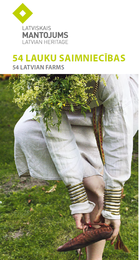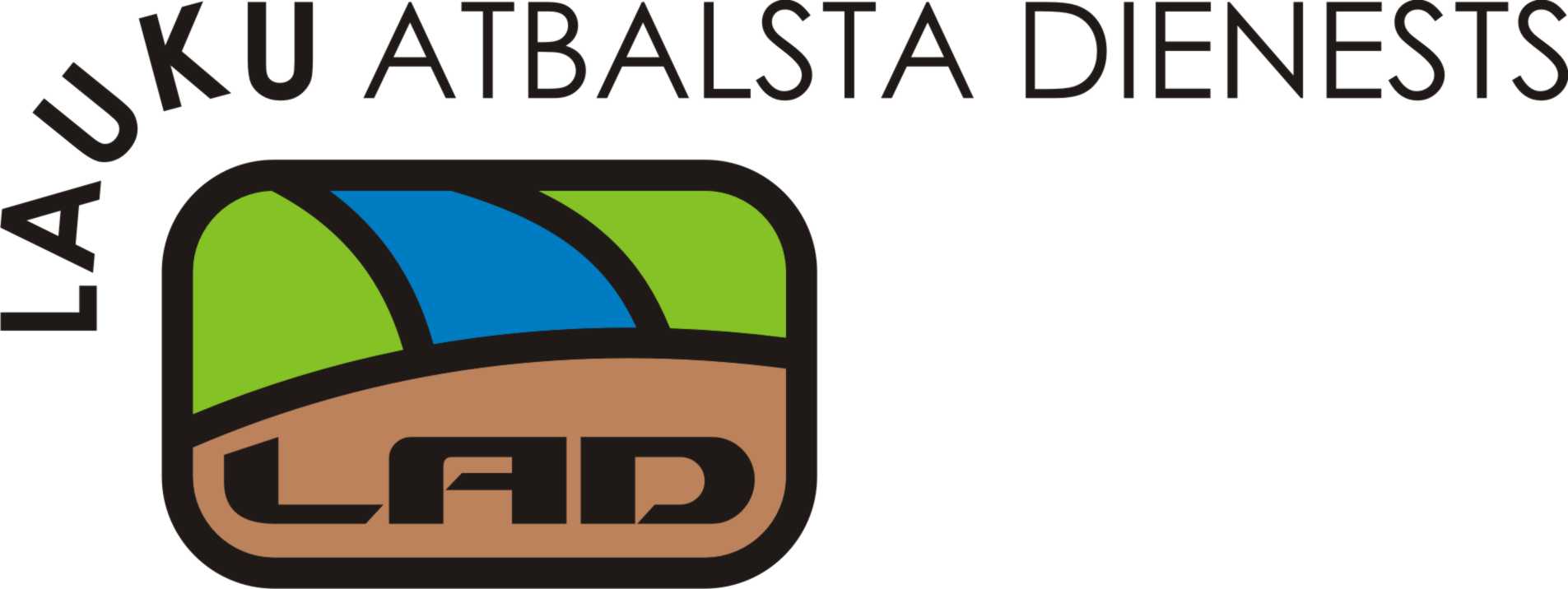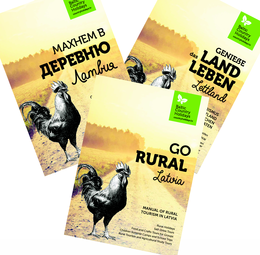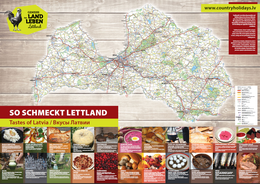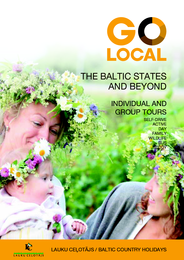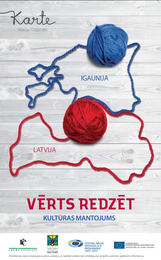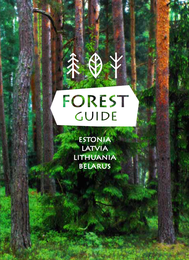Reiseliteratur
Von "Lauku ceļotājs"Um die Publikationen zu bestellen, schreiben Sie bitte eine E-mail an lauku@celotajs.lv. Sie können mit Kreditkarte oder per Banküberweisung zahlen. |
| Publication | Description |
|---|---|
Karte für Wanderungen - Lettlanddiese Karte umfasst 10 routen für Wanderungen, die auf der Karte 25 eingezeichnet und auf der anderen Seite der Karte beschrieben sind. diese Karte umfasst allgemeine informationen über die darin beschriebenen routen für Wanderungen, darum muss man vor der reise zusätzliche informationen über den Zustand des objekts, transport, unterkunftsmöglichkeiten usw. sammeln, sowie klären, ob objekte zu dem Zeitpunkt der reise wegen einer rekonstruktion nicht geschlossen sind. die routen führen meistens die Küste entlang, auf kleinen Waldpfaden, Flussufer entlang, die als gute Wegweiser dienen. diese Karte umfasst auch 63 kurze naturpfade , 38 orte für spaziergänge (Parks, landschaftliche Gegenden usw.) , und 142 Aussichtsorte , darunter - 72 Aussichts- und Vogelbeobachtungstürme . diese objekte befinden sich auf mehr als 50 verschiedenen besonders geschützten naturgebieten . Viele von den erwähnten Sehenswürdigkeiten sind kulturdenkmäler . einige etappen der routen kann man auch im Winter auf skiern erkunden. auf einigen routen oder teilen von diesen routen kann man mit dem Fahrrad fahren. die routen kann man auch für nordic-Walking benutzen. |
|
Latvian Heritage - 54 Latvian farmsThe „Latvian Heritage” sign of culture is meant for tourism businesspeople in Latvia who preserve and popularise Latvian cultural heritage by presenting it to visitors. The sign was established at the initiative of „Lauku ceļotājs” so as to honour and create Latvia’s cultural and household heritage as it exists today. The sign will indicate locations where owners are prepared to provide information to visitors, show things, serve Latvian dishes, teach crafts and skills, and celebrate Latvian festivals. The sign of Latvian heritage will be given to accommodations, farms, craftspeople, countryside saloons, organisers and directors of events related to Latvian traditions, museums, collections, and specialists in various skills and crafts. The sign has been presented since 2013 in partnership with the Latvian Ministry of Culture and the Latvian Association of Local Government. |
|
Wellbeing Tourism in LatviaThese leisure offers are intended to provide you with feelings of emotional, physical and spiritual wellbeing. Peace, quiet, open spaces, fresh air, pampering yourself, a healthy lifestyle, gentle exercise, beautiful surroundings, closeness to nature - all of these are skilfully merged to provide you with a sense of harmony, balance in your inner world, and to revitalise your energy. In Latvia, people has known for centuries how to use nature materials for their health and wellbeing. The knowledge about preparation of herbal teas, sauna switches, body masks and scrubs are inherited from generation to generation. |
|
Radwanderkarte LETTLAND, LITAUEN, ESTLAND9 Radtouren, 240 Sehenswürdigkeiten, praktische Reiseinformation über das Baltikum. Auf dieser Radtourenkarte sind 9 Radtouren, sowie 240 touristische Attraktionen entlang dieser Radtouren in den drei baltischen Ländern kurz beschrieben. |
|
Marketing project results"Marketing Campaign for Promotion of Rural Tourism and Development of Rural Tourism Products in all the Regions of Latvia" Project goalImplement rural tourism marketing campaign by creating and promoting rural tourism products that are based on rural resources and traditional values: local and regional food, culture and rural trade, producers of rural products. Project keynote – collaboration in all levelsContent of the Project mainly developed through discus- sions and collaboration with farmers, agricultural orga- nizations and local tourism information centres. Personal approach, discussions, seminars and surveys reflected the actual situation in the countryside and the needs of the farmers and the rural tourism. We organized meetings with entrepreneurs inspecting both opened to the visitors farms of „Countryside goodies” and public catering places that offer Latvian food. Rural tourism products that are developed during the Project are based on possibilities of the current offer taking into account references of the tourists and market tendencies. Due to participation, co-operation and personal interest of the farmers we have successfully implemented in practice the concept of “Go Rural”, developed the rural tourism products, organized “Open Days in the Countryside”, and developed criteria of “Latvian Food” and culinary product „Latvian Cuisine”.
|
|
LETTISCHE GERICHTE UND GETRÄNKELettland hat sehr reiche Esstraditionen, weil das Land sich am Kreuzweg Europas befindet und in den vorigen Jahrhunderten Völker aus dem Osten und Westen es beeinflusst haben. Die lettische Küche hängt von der Saison ab, weil wir vier Jahreszeiten haben, von denen jede ihre eigenen besonderen Produkte und Genüsse anbietet. Im Frühling wird der Lette ungeduldig schauen, ob die Birkensäfte schon rinnen. Er wird auf der Fensterbank den ersten grünen Schnittlauch aus Zwiebeln keimen lassen. Zu Ostern färbt der Lette Eier in Zwiebelschalen. Er sucht nach dem ersten Ampfer im Garten oder auf der Wiese. Aus Rhabarbern backt er einen Blechkuchen. Den Sommer fängt der Lette mit Garten- und Wald- Erdbeeren an. Zu Sommersonnenwende isst er den Johanniskäse mit Kümmel und trinkt Bier. Im Sommer genießt er die neuen Kartoffeln, Kirchen, Tomaten und duftende Äpfel aus seinem eigenen Garten, Eis aus Sahne, frischen Honig und Kräutertees. Er rührt einen Grießbrei zu Himmelsbrei schaumig. Er backt Pilze und legt sie ein. Pilzsammeln und Angeln sind für den Letten fast wie ein Ritual oder Meditation. Er backt auf Feuer Fleisch oder kocht eine Fischsuppe. Er ist bereit, den Sauerrahm und frische Dille fast jedem Essen beizufügen. Er backt einen Kringel zu Geburtstag oder eine Torte zu einer Hochzeit. Er legt Gurken ein und kocht Marmeladen, trocknet verschiedene Köstlichkeiten aus dem Wald oder Garten und legt ins Tiefkühl, weil ein langer Winter vor der Tür steht. Wenn der Herbst kommt, wird das Essen des Letten nahrhafter. Im Herbst wird der Mikelis-Tag (Herbstsonnenwende) und Martins-Tag (Ende des Herbstes) gefeiert, im Ofen werden ein gefühlter Hahn oder eine gefühlte Gans, aber als Nachtisch – ein Apfelkuchen oder Mohnbrötchen gebacken. Im Herbst helfen die Letten bei der Ernte. Es werden Kartoffelpfannkuchen gebacken, Fische, Schweinefleisch, Würstchen und sogar Käse geräuchert. Auf einer Schwarzbrotscheibe wird frische Butter geschmiert. Es wird ein Moosbeerensaft gemacht. Auf Jahrmärkten wird alles verkauft und gekauft, was im Sommer gezüchtet wurde. Der Tisch zu Weihnachtszeit ist der reichste, dann werden Speckpiroggen, Pfefferkuchen und Braten gebacken, sowie Sauerkraut gekocht. Am Silvesterabend wird ein Fisch vorbereitet, dessen Schuppen im Geldbeutel gelegt werden, damit man Geld hat. Aber Erbsen werden bis auf der letzten Erbse aufgegessen, damit man im nächsten Jahr nicht viel weinen müsste. Es gibt einen Volksglauben, dass man am Silvesterabend wenigstens neun Gerichte essen muss und auf dem Tisch nichts fehlen darf, dann wird das nächste Jahr gut sein. Der Lette ist gastfreundlich, darum bringt er immer ein Gastgeschenk und lässt seinen Gast nie mit leerem Bauch wegfahren. |
|
Kulinarische karte LettlandDiese Karte umfasst 178 Gaststätten, Cafés, Restaurants, Unterkünfte auf dem Lande u.a. Verpflegungsanbieter im ganzen Lettland (außer Riga), die lettische Gerichte vorbereiten und lettische Traditionen pflegen. Über Verpflegungsanbieter: Kurze Beschreibung, Name, Öffnungszeiten, Kontaktinformationen, geographische Koordinaten, Standort auf der Karte. In der Beschreibung jedes Anbieters sind die angebotenen lettischen Gerichte und das besondere Gericht des Hauses aufgezählt. Beachten Sie bitte, dass ein Teil der Orte, die Verpflegung anbieten, nicht immer geöffnet sind, aber sie arbeiten nur auf vorheriger Anmeldung (s. das Symbol Nur auf vorheriger Anmeldung). Wenn Sie als eine Gruppe (mehr als 6 Personen) unterwegs sind, dann melden Sie sich bitte bei jedem Verpflegungsanbieter an, damit Ihnen die Gerichte schneller serviert werden könnten. Auf der Karte Lettlands, Maßstab 1: 550 000, sind alle hier beschriebenen Verpflegungsanbieter 1 markiert. Auf der Karte sind auch 10 Kulinarische Wege Lettlands eingezeichnet. Diese Wege sind auf der rechten Seite der Karte kurz beschrieben, aber die volle Beschreibung dieser Routen können Sie auf dieser Internetseite finden: www.tures.countryholidays.lv |
|
GENIEßE DAS LANDLEBENGenießen das landleben ist ein Handbuch für Landtourismus in Lettland sowohl für Touristen, als auch für Reisefachleute. In dieser Broschüre versuchen wir, Lettland mit Hilfe von den besten Produkten und Menschen zu zeigen, die diese Produkte herstellen und züchten. Wir heben ländliche Atmosphäre und Orte hervor, die Sie besuchen können und wo Sie sich so entspannen könnten, als ob Sie Ihre Großmutter auf dem Lande besuchen hätten. Sie können in Gärten gehen und selber Obst und Gemüse sammeln. Es gibt auch einige Orte, wo während der entsprechenden Saison Veranstaltungen organisiert werden, auf denen man Beeren und Früchte sammeln kann. Einige von unseren Touren für Fahrten mit dem PKW sind ideal für Familien mit Kindern. Auf diesen Touren können Kinder sehen und lernen, woher das Essen kommt, sie können Haustiere füttern und streicheln und die Natur genießen. Wir organisieren auch Touren für Schüler, die mit dem Leben auf dem Lande, der Züchtung und Herstellung von Lebensmitteln bekanntmachen, diese Touren bieten viel Freude an, die unsere Natur schenkt, sowie sehr viel freien Raum. In unseren Touren möchten wir den typischen Geschmack Lettlands hervorheben, darum bieten wir verschiedene Verkostungen auf Höfen, in Landhäusern, lokalen Wirtshäusern und Restaurants an. Wir haben einige Touren mit Verkostungen von Speisen und Getränken für Gruppen, sowie solche Touren ausgearbeitet, auf denen man das handwerkliche Können der Handwerker lernen kann. Da wir eine langjährige Erfahrung haben, organisieren wir auch landwirtschaftliche Touren für Fachleute und beraten in Fragen über Landtourismus. |
|
Latvian Heritage - 40 Latvian farmsThe „Latvian Heritage” sign of culture is meant for tourism businesspeople in Latvia who preserve and popularise Latvian cultural heritage by presenting it to visitors. The sign was established at the initiative of „Lauku ceļotājs” so as to honour and create Latvia’s cultural and household heritage as it exists today. The sign will indicate locations where owners are prepared to provide information to visitors, show things, serve Latvian dishes, teach crafts and skills, and celebrate Latvian festivals. The sign of Latvian heritage will be given to accommodations, farms, craftspeople, countryside saloons, organisers and directors of events related to Latvian traditions, museums, collections, and specialists in various skills and crafts. The sign has been presented since 2013 in partnership with the Latvian Ministry of Culture and the Latvian Association of Local Government. |
|
So Schmeckt LettlandTraditionelle Gaststätten,Bauernmärkte und Hofl äden können Sie auf unsere Webseite unter dem Stichwort” Sehenswertes” fi nden. Wir organisieren auch kulinarische Touren zu Bauernhöfen mit Verkostung und laden ein bei der Herstellung von regionalen Produkten teil zu nehmen. |
|
Go Local - Das Baltikum und mehrIndividuelle Touren und Touren für GruppenFahrten mit dem PKW, Aktivtouren, Tagesausflüge, Touren für Familien, Naturtouren, Bustouren, BildungstourenDie Menschen im Baltikum haben eine enge Beziehung mit der Natur und leben im Jahreszyklus der Natur. Jede Saison bietet ihre besonderen Aktivitäten an, z.B. Pilzsammeln, Beerensammeln, Kräutersammeln, Eisangeln und verschiedene Arbeiten auf dem Land, sowie traditionelle Feste und Saisonfeste. Auf dem Land können sich die Touristen, die Traditionen hochschätzen, die Natur lieben und die Länder und ihre Kultur tiefer kennenlernen möchten, wie im Himmel fühlen. Unsere Touren, die wir gut erforscht haben, führen an solchen Sehenswürdigkeiten und an solchen Orten vorbei, wo sich Unterkünfte mit einer kleinen Bettenzahl, Höfe und lokale Hersteller befinden, Traditionen gepflegt werden und herzliche Menschen wohnen. Viele Jahre haben wir regelmäßig unsere Unterkünfte und Sehenswürdigkeiten überprüft, mit Naturparks und Naturexperten eng zusammengearbeitet, sowie neue Touren erforscht und ausgearbeitet. Wir sind immer auf der Suche nach lokalen Höfen und Herstellern und fördern die Entwicklung von neuen Produkten. Da es uns selber gefällt, aktiv zu sein und zu erforschen, haben wir alle Touren auf verschiedene Weisen ausprobiert: auf dem Fahrrad, zu Fuß, mit dem Kanu, mit dem Auto und mit dem öffentlichen Verkehr. Wir haben das Gefühl, dass wir uns die Experten des Baltikums nennen können. Auf Ihrer Anfrage können wir für Sie eine Tour durch die baltischen Staaten zusammenstellen, die ganz Ihren individuellen Wünschen und Interessen angepasst ist. Wir stellen den Reisenden detaillierte Straßenkarten und Wegbeschreibungen für alle unsere Touren zur Verfügung. Mehr auf der Internetseite von Baltic Country Holidays: www.countryholidays.lv |
|
Karte Es ist wert zu sehen Kulturerbe Estland, LettlandDie Verbände für Tourismus auf dem Land in Lettland (Lauku Celotajs) und in Estland (Eesti maaturism) habe eine Kulturerbe-Karte mit 150 wunderbaren Orten ausgearbeitet, an denen die Objekte und Traditionen, die der entsprechenden Region charakteristisch sind, nicht nur gepflegt werden, sondern sie sind auch den Reisenden zur Erkundung zugänglich. Das Verständnis des Kulturerbes ist sehr umfassend, darum lädt diese Karte ein, unterschiedliche Orte und Aktivitäten zu besuchen: Handwerker und Handwerkszentren, Personen, die traditionelle Gerichte und Getränke vorbereiten, kleine Lebensmittelhersteller, Fischer, Orte, wo traditionelle jährliche Feste (z.B. Sommer-Sonnenwende) gefeiert werden, Höfe, wo man an Arbeiten auf dem Lande teilnehmen kann und wo Kinder Haustiere kennenlernen können, Wirtshäuser, Museen und Sammlungen, Industrielle Denkmäler, historische Stadtzentren, ethnographische Dörfer und Gebiete, mit der Geschichte verbundene thematische Veranstaltungen und Rekonstruktionen von Ereignissen, sakrale Orte und Gebäude, einzelne Schlösser und Landgüter, Orte, wo man dem Lande charakteristische Souvenirs kaufen kann, Pfade und Routen, sowie andere Objekte, in denen für die Reisenden ein besonderes Angebot erarbeitet worden ist. |
|
Country Holidays 2013This catalogue contains practical information which will help you to plan your weekends Contents:
In English, Latvian and Russian. |
|
Forest guide - Estonia, Latvia, Lithuania, BelorussiaThe Baltic Sea region is the most wooded territory in Europe. Unlike other parts of the continent, this region saw the emergence of forests over the course of 12,000 years after the last so-called Baltic Ice Age. Since the region covers a fairly large part of Europe, it is rather diverse. Boreal coniferous forests dominate in the northern stretches, while temperate broadleaf forests are found in the central and southern parts. The Baltic States and Belarus are located in the transition zone between these two types of forests. This is one of the reasons why great biological diversity is observed in the territory. The swamp forests that are found there are often known as ‘the Northern rainforests’. The forest is an integral component of the Northern European landscape and cultural environment. Over the course of ages, forests and trees have served as sources of inspiration, leading to countless legends, stories, fairy tales and riddles as a very important part of the intangible folklore heritage of Northern European peoples. The forest has always been an important source of timber and non-timber (mushrooms, berries) resources in the economies of the Baltic countries. This guide will help you to learn more about the unique aspects of our forest and its nature values.
Part-financed by the European Union (European Regional Development Fund and European Neighbourhood and Partnership Instrument) |
|
Reiseführer entlang der Ostseeküste. LettlandDer Reiseführer ist als Ratgeber für die Planung einer Reise entlang der lettischen Ostseeküste zu empfehlen. Mit Hilfe dieses Reiseführers finden Sie passende Übernachtungsmöglichkeiten und Ideen für Ihre Freizeit am Meer. Die Küste ist landschaftlich sehr vielfältig und erstreckt sich über 500 km. In Lettland finden Sie sowohl sandige als auch steinige und steile Küstenabschnitte. Die Ferienorte in der Nähe von Riga und Jurmala sind im Sommer voller Leben. Auf dem Land und in den kleinen Fischerdörfern finden Sie Ihre Ruhe, Erholung und wunderschöne Natur. Der Reiseführer beinhaltet
Klicken Sie hier, um die elektronische Version dieses Reiseführers runterzuladen. Der Reiseführer ist in Englischer, Deutscher und Russischer Sprache zugänglich. |
|



